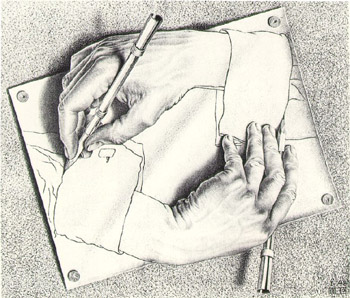Thursday, 26 October 2017
The Brain, The Body and the Environment: We Need All Three To Make Thinking Possible

The third and final session of my course at UPop Montréal started by asking whether our brains really process our most abstract concepts in the way proposed by cognitivist theory: that is, as arbitrary symbols that have nothing to do with the sensory modalities by which these “inputs” are entered. But as early as the 1960s, experiments with the mental rotation of objects seemed to suggest that, on the contrary, when we perform “high-level” mental manipulations of this kind, we employ the sensory regions of our brain to do so.
Over the ensuing years, the accumulated data from such experiments gave rise to a diametrically opposite approach to the cerebral bases of our abstract categories, known as the modal approach, according to which we re-use our brain’s sensory and motor modalities to create conceptual representations. This idea of re-use is part of a broader approach advanced by many contemporary authors such as Michael Anderson, Stanislas Dehaene and Luiz Pessoa, whose article “A Network Model of the Emotional Brain” was mentioned in our blog post of 11 October 2017.
And for the advocates of a “strong” embodied approach to cognition, who would seek to eliminate the notion of mental representation as much as possible, this is a step in the right direction. In their view, the environment is the ultimate source of our conceptual categories and “invites itself” into the brain whenever we conceptualize something by activating the sensorimotor areas that we originally used to interact with one or more examples of the category to which that thing belongs, out in the real world.
But some authors, such as Andy Clark and Francisco Varela, say we should go even further and regard our perceptions of the world and the actions that we take in it as dynamic loops, a form of coupling between ourselves and our environment. One good example is the way that an outfielder goes about catching a baseball, which shows just how closely that player’s movement across the outfield is coupled with the perception of the ball at the centre of his or her retinas.
This kind of analysis strikes a harsh blow at the classical Cartesian schema of “perception –> mind –> action”. Even if we replace “mind” with “cognition”, this linear sequence does not match what is actually going on in our brains all the time, according to the pragmatic, embodied perspective that cognitive science has increasingly adopted over the past decade or two. This trend in fact constitutes a return to the evolutionary sources of the structure of our nervous systems, which developed for the basic purpose of letting us find resources in our environment without getting ourselves hurt or killed in the process. If the entire history of our brain’s evolution had occurred in only 24 hours, then its more sophisticated products—philosophy, for example, or the various possible openings in a game of chess—would have come about in only the past few seconds.
This perspective forces us to revisit our traditional views of many of what we consider the brain’s “higher functions”, and in particular our traditional view of decision-making, which this pragmatic, staunchly action-oriented approach overturns completely. According to this approach, strange as it may seem, the making of a decision does not chronologically precede the selection of motor commands to execute it. Most of the time, it is actually the reverse: at any given moment, our environment is suggesting to us various opportunities to take action (“affordances”, to use the term first proposed by psychologist James J. Gibson). According to the affordance-competition hypothesis developed by Dr. Paul Cisek of the University of Montreal, the brain translates these opportunities or affordances into activity in various assemblies of neurons that “compete” with one another, and the “winning” assembly produces the behaviour that we will perceive as the one that we decided upon. So yes, far more things than we realize are going on in our brains, and many of our “decisions” are really only language-based rationalizations after the fact.
Lastly, another “hot topic” in cognitive science for at least the past 10 years is the idea that the human brain basically functions as a machine that makes predictions about what is going to happen in the next moment. This general theory of “predictive processing” adopts the essential features of the pragmatic approach described above, retaining the idea of internal models of the outside world but describing them as probabilistic models whose effect on the outside world can reduce errors of prediction. Closing the loop, in this model, the errors of prediction that do occur constantly update these internal models at every neuronal level of the brain, from the most unimodal and sensory to the most multimodal and associative.
Once again, our brains appear to spend far less time than we once believed on making maps of an outside world that is independent of them, and much more time on continuously refining the best possible model of a dynamic system that influences the world and is constantly influenced by it—exactly as in the drawing by Escher that accompanies this post and that will give you a major headache if you keep trying to figure out where the body ends and where the outside environment begins. But that is a whole other topic—extended cognition, on which much has been written by authors such as Clark and Chalmers. A good example of extended cognition would be those cases in which your cell phone becomes an integral part of your cognition instead of just “giving it a little help”.
Body Movement and the Brain | No comments







